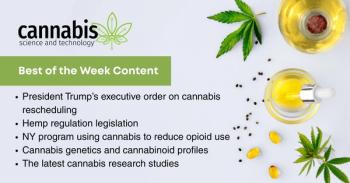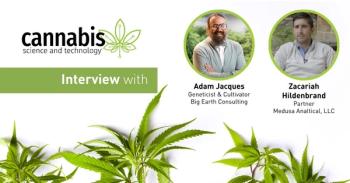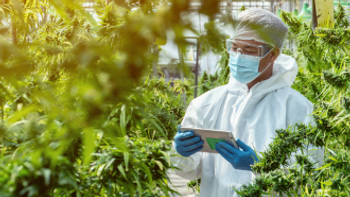
Cannabis Science and Technology
- April 2020
- Volume 3
- Issue 3
The Root of Success: Using the Right Growth Substrate

Let’s explore some options for growth substrates that are essential to the health of your plants.
The selection and use of the right growth substrate for your cultivation is essential for healthy high-producing cannabis plants. There is no “one-size fits-all” when it comes to deciding on the growth substrate that will support and provide the nutritional environment across the life cycle of your plants. In this column, we explore some options for growth substrates that are essential to the health of your plants.
We often are asked the question, “What is the best growth substrate for my cannabis?” We wish there was a simple, single answer, but the answer is always, “It depends.” It is important to start to think of cannabis cultivation as a horticultural system that can be optimized and not simply an agricultural one-size-fits-all crop. When deciding on the growth substrate, also called the hydroponic substrate, you will need to consider all of the variables that will affect the taste, yield, uniformity, and quality, “organic properties,” whether you are growing indoors or will cultivate sun-grown plants, and the potential benefits of the complex soil food web versus possible plant pathogens that could damage your buds, especially if you cultivate outdoors.
This column focuses on hydroponic substrates to be used in controlled environment agriculture (CEA) settings, such as greenhouses and warehouses. If you are cultivating outdoors, we assume you will be planting in soil and we will discuss this option only briefly in this column.
What Are Hydroponic Substrates?
Let’s take a moment to discuss the differences between soil and a hydroponic substrate. In general, Earth’s soil is rich with organic material, such as bacteria, fungi, insects, and decaying leaves that provide part of the complex nutrient system that will feed the plants. We might think of it as a “living soil” because it is filled with microscopic life that assists with nutrient development and absorption. In contrast, hydroponic substrates are a set of “root-supporting” granular or fibrous materials that have little or no components able to provide nutrients to the plants. All nutrients for hydroponic systems must come from the water-based nutrient solutions that you provide through fertigation. Hydroponic growth substrate materials are best considered as an architectural support structure that ensure the roots have a strong and solid base to support the heavy plant structures as shown in Figure 1, such as the stems, leaves, and flowers. The hydroponic growth substrate is porous, meaning that it is filled with tiny holes and complex pathways for the flow of water and nutrients around the growing root system. The solids in a hydroponic growth substrate are inert support materials, while the hollow pore space allows room for the roots to grow and fertigation liquids to flow. The pore space allows for the flow of water, nutrients, and air (oxygen) to the roots for immediate absorption into the plant.
Functions of the Hydroponic Substrate
Hydroponic substrates perform several functions to enable plant growth. First, and most obvious, is that the substrates provide an anchor that enables the cannabis plant to grow and remain upright. It does so by providing a complex three-dimensional (3D) matrix for the root system to infiltrate the pore space and support the plant. However, this is just the beginning of the benefits of the hydroponic substrate: it provides a habitat for the overwhelming number of beneficial and benign microorganisms to live. This high concentration and close proximity make them readily available to colonize the growing roots and microscopic root hairs. Colonizing roots with beneficial and benign organisms limits or prevents the attachment of harmful pathogenic fungi and bacteria.
Hydroponic substrates, such as coco coir, have the capacity to bind nutrients. This is particularly true for micronutrients such as calcium and magnesium. Regardless of the substrate choice, the surface of the substrate itself will become colonized with microbes that create an enhanced complex surface structure, called a biofilm, that can assist with nutrient absorption. This biofilm develops with time and becomes a local source of micronutrients as the microbes increase in number and build the more complex surface structure.
Finally, the hydroponic substrate ensures the maintenance of a proper balance between air (oxygen) and the nutrient solution for the root system. The selection of the appropriate substrate will guarantee that these essential components of plant health are available at the right time and the right place to optimize plant growth and maintenance from seedling to harvest.
Two Top Hydroponic Substrates
Your choice of hydroponic substrate depends on the type of cultivation facilities you are growing in and the goals of your cultivation.
Coco Coir
Coco coir seems improbable since it is made from the rough fibrous husk of coconuts, but it is an excellent organic product as a hydroponic substrate (Figure 3). It has been used for thousands of years as a strong material in a wide variety of products from door mats to plant growing medium. It is highly inert and holds water very well. It is a sustainable resource that provides an Earth-friendly approach to your operations.
Rockwool
Rockwool is made from the mineral basalt and contains no organic material (Figure 4). It is a sterile, porous, easy-to-work-with lightweight hydroponic substrate. It is not yet recyclable, but can be repurposed into an outdoor soil amendment. The key factor for selection of rockwool is its sterility, cleanliness, and ability to maintain a proper water to air mixture at the root level with the nutrient solution.
Key Parameters
There are four key parameters that affect the performance of the hydroponic substrate. Comparing and contrasting the performance of these parameters in your choice of substrate will ensure that you can make a logical and fully-vetted decision on which to use. The key parameters are:
1.Irrigation Strategy
We prefer top drip irrigation with frequent “watering cycles.” Infrequent heavy watering creates runoff flow channels through the substrate. The result is fewer roots at the top of the substrate matrix and lowered nutrient uptake for the plants. Some runoff, about 20%, is needed to flush salt build-up for a drain to waste system.
2.pH
The best pH for a hydroponic system ranges between 5.5 and 6.5, slightly acidic. pH is important to maintain optimal nutrient availability for the plant, but is not as important as most people think. If you are running a drain to waste drip irrigation system where nutrients are being replenished with each irrigation cycle, it is much less important. If your system is a closed-loop recycled system more care must be taken to maintain proper pH.
3.EC
Because of the minimal ability of rockwool to retain nutrients, the hydroponic solution must be supplied at a higher level and be more nutrient rich than for coco coir. The coco coir itself provides some slow-release nutrient value by virtue of its organic composition, but it is minimal.
4.Wettability
Rockwool can retain 90–94% of its volume with water. While coco coir retention varies with the source; it is typically in the mid-60%. Both are satisfactory in this key parameter. Irrigation should be short and frequent to enable full saturation of the matrix and drying to properly occur in both substrates.
Recommendations
For those of you interested in producing an “organic” product the choice is clear: select coco coir as your hydroponic substrate. Once it is properly prepared, it provides an easy-to-work-with medium that fosters a strong growth environment to support the plant and for bio-film formation for the root-based beneficial microbes supporting nutrient absorption. However, be aware that the system is messy to work with and brings with it additional labor costs for preparation and clean-up. It is also not sterile because that is not part of the vendors’ process; I have seen fungal infections that were ultimately attributed to the coco coir source. So, coco coir provides an excellent hydroponic substrate, but you must be willing to work within the constraints of preparation and possible fungal infections. With diligence and care, it can be your go-to substrate in your greenhouse or warehouse.
In addition, we recommend rockwool for hydroponic use. Rockwool is an inorganic porous material formed at extremely high temperatures through a manufacturing process. On the plus side, it arrives at your cultivation site as a sterile product. It will not introduce pathogens to your facility. If your focus is on minimizing contamination, it is the clear choice. It’s easy to start clean and stay clean with rockwool. The use of inorganic mineral salt fertilizers makes the system more suitable for short and repeated irrigation as it reduces likelihood of plugging and clogging of fertigation lines. This means it is much more compatible for automated irrigation systems because there is reduced contact between workers and the plants, thus lowering the opportunities for the transfer of plant and human pathogens. If your top priority is to start clean and stay clean, we recommend implementing a rockwool substrate across your cultivation facility. You will thank yourself with healthy plants over their full life cycle.
Conclusion
When choosing the right hydroponic substrate for your cultivation site, you need to consider your overall goals and the system that you want to optimize for taste, yield, quality, and uniformity in your final products. If your priority is to grow organically, you would select coco coir. On the other hand, if your priority is to grow to minimize plant diseases, you would select rockwool. Regardless of the substrate you choose, you will still have to manage plant pathogens and pests. In all cases, growing and producing healthful and desirable buds is a hard job, but well worth the extra effort when you bring a measurable and scientific approach to cultivation. We have seen both of these particular substrates produce healthy plants and a wonderful final product.
About the Coauthor
Dr. Jacklyn R. Green is a project manager, systems engineer, and scientist focused on today’s commercial cannabis enterprise. She is the CEO of Agate Biosciences LLC, an innovation consultancy. With her PhD from The University of Texas at Austin, she focuses on investment assessments, due diligence, and project management. She spent 27 years at NASA’s Jet Propulsion Laboratory as a scientist and project manager, leading advanced technology development projects and proposal development in the complex government-regulated environment. Now, as the Chief Executive Officer of Agate Biosciences, she brings the best practices of detailed research, project management, and systems engineering to angel investing, venture capital, and private equity clients.
About the Columnist
Dr. Roger Kern is a scientist and technologist who cares deeply about the cultivation and health of plants in the cannabis industry. With his PhD in microbiology from the University of California, Davis, Plant Growth Laboratory, he solves the most challenging problems in hydroponics, from studying the root microbiome to developing nutrients and lighting systems to ensure plant health and a disease-free life cycle. He spent 22 years at NASA’s Jet Propulsion Laboratory as a scientist, technologist, and research leader before becoming the President of Agate Biosciences, a consulting firm for project management, systems engineering, and science in CEA for the past eight years. He leads developments to optimize sustainability, consistency, quality, and yield without compromising plant health. Direct correspondence to:
How to Cite this Article
R. Kern and J.R. Green, Cannabis Science and Technology3(3), 16–19 (2020).
Articles in this issue
over 5 years ago
Co-Solvent Ethanol Injection Helping CO2 Extractionover 5 years ago
Beyond Potency: Flavonoids-the Purples, Reds, and BluesNewsletter
Unlock the latest breakthroughs in cannabis science—subscribe now to get expert insights, research, and industry updates delivered to your inbox.



